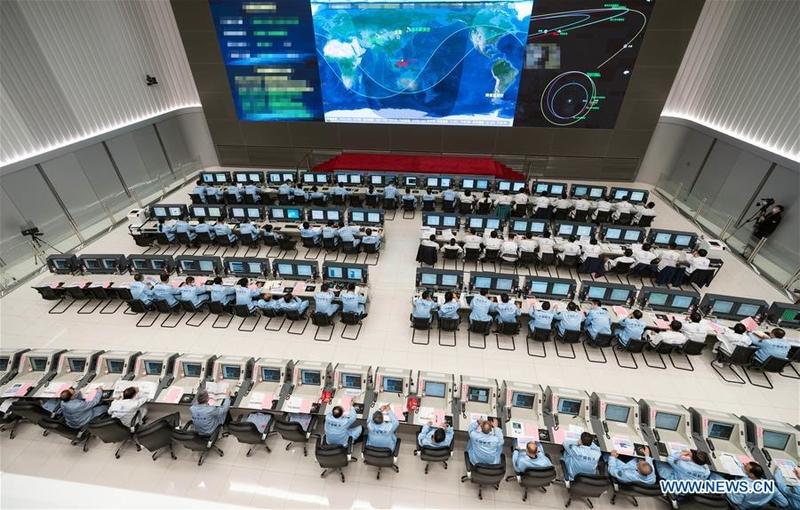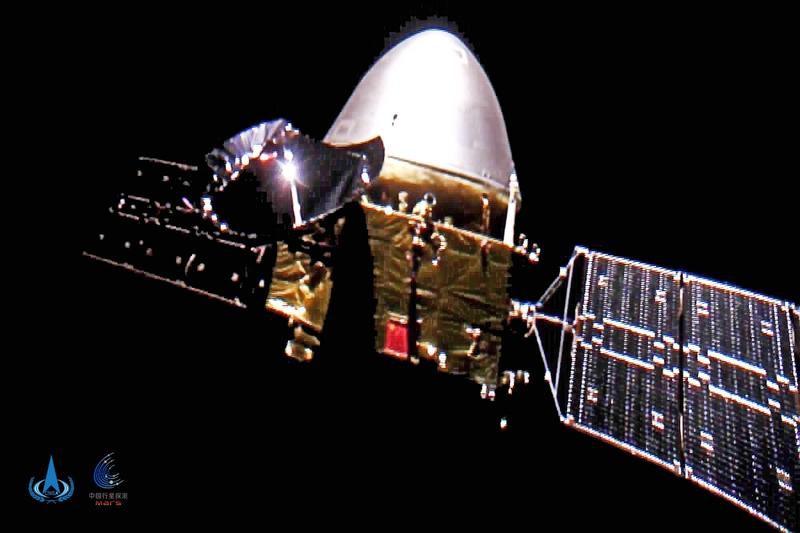 Technical personnel work at the Beijing Aerospace Control Center (BACC) in Beijing, capital of China, Oct 9, 2020. China's Mars probe Tianwen-1 successfully conducted a deep-space maneuver on Oct 9, 2020, according to the China National Space Administration. (CAI YANG/XINHUA)
Technical personnel work at the Beijing Aerospace Control Center (BACC) in Beijing, capital of China, Oct 9, 2020. China's Mars probe Tianwen-1 successfully conducted a deep-space maneuver on Oct 9, 2020, according to the China National Space Administration. (CAI YANG/XINHUA)
China's Tianwen 1 Mars probe carried out a key in-flight maneuver about 30 million kilometers away from Earth on Friday night.
The deep-space orbital operation began at 11 pm, after the robotic vehicle received signals from ground controllers at the Beijing Aerospace Control Center. Its main engine, which has 3,000 newtons of thrust power, was activated and operated about eight minutes, moving the spacecraft toward a Martian orbit.
READ MORE: China's Mars probe photographs Earth and Moon
The spacecraft will continue traveling about four months in an Earth-Mars transfer trajectory toward the red planet and will conduct two to three more orbital corrections before entering Mars' gravitational field, according to the China National Space Administration.
Rao Wei, a project manager for Tianwen 1 at the China Academy of Space Technology, said on Friday night that the elaborately designed maneuver was intended to adjust the flight route to enable the spacecraft to fly accurately toward the preset point where the vehicle is expected to be captured by Mars' gravity at the beginning of 2021.
 Mars probe Tianwen 1 is seen in its first selfies in space on Oct 1, 2020. (PHOTO/XINHUA)
Mars probe Tianwen 1 is seen in its first selfies in space on Oct 1, 2020. (PHOTO/XINHUA)
The operation will also allow the probe to continue its journey in a fuel-efficient manner, he explained.
The biggest challenge in tonight's operation was that the 3,000-newton-thrust engine would need to work for a relatively long period of time under very high pressure and temperature.
Rao Wei, project manager for Tianwen 1 at China Academy of Space Technology
"The biggest challenge in tonight's operation was that the 3,000-newton-thrust engine would need to work for a relatively long period of time under very high pressure and temperature," Rao said, adding that the long-distance control and tracking was also a major challenge.
Cui Xiaofeng, the Mars mission's chief controller at the Beijing Aerospace Control Center, said that his team carried out a series of high-accuracy orbital calculations to make sure the deep-space maneuver would achieve its goal. He noted that this move will be crucial to Tianwen 1's future steps.
By Friday night, Tianwen 1 had traveled more than 210 million kilometers, Rao said, adding that the spacecraft is in good condition. The probe has performed two midcourse orbital corrections.
China launched Tianwen 1, the country's first independent Mars mission, on July 23 at the Wenchang Space Launch Center in Hainan province, opening the nation's planetary exploration program.
ALSO READ: China's Tianwen-1 takes photos en route to Mars
If everything goes according to schedule, the 5-metric-ton Tianwen 1, which consists of two major parts-an orbiter and a landing capsule-will travel more than 470 million km before its capture by the Martian gravitational field in February, when it will be 193 million km away from Earth.
The mission's ultimate goal is to soft-land a rover around May 2021 on the southern part of Mars' Utopia Planitia-a large plain within Utopia, the largest recognized impact basin in the solar system-to make scientific surveys.


